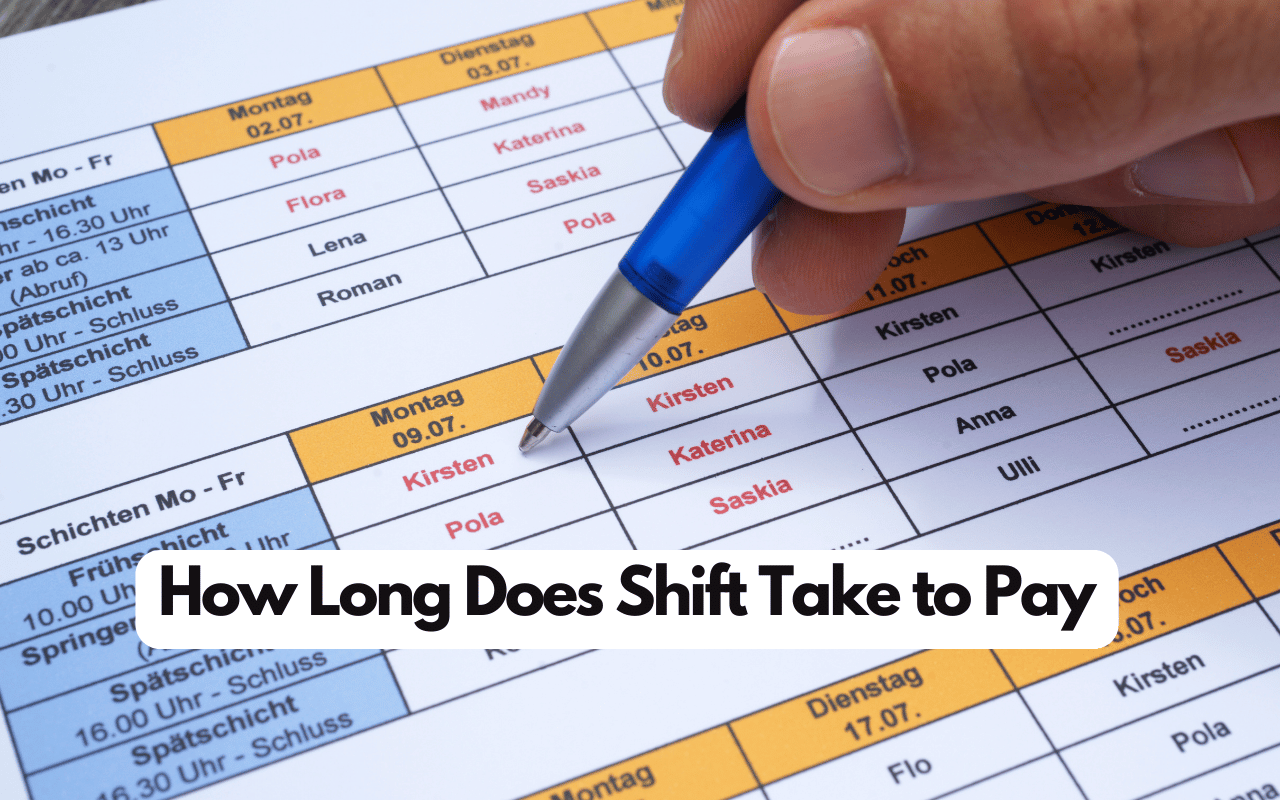How Long Does Shift Take to Pay: Quick Guide

How long does shift take to pay? This question is crucial for many workers. Understanding shift pay timing is essential for effective financial planning. In this comprehensive guide, we’ll delve deep into the factors affecting payment duration and provide valuable insights for both employers and employees.
- How Long Does Shift Take to Pay: Quick Guide
- Understanding the Basics of Shift Pay
- Factors Affecting Shift Pay Duration
- 1. Company Size and Structure
- 2. Payroll System Efficiency
- 3. Pay Period Frequency
- 4. Accuracy of Time Tracking
- 5. Company Policies and Procedures
- Average Duration for Shift Pay Processing
- Typical Processing Times
- Pay Cycle Considerations
- Tips for Expediting Shift Pay
- For Employees:
- For Employers:
- Impact of Delayed Shift Pay on Employees
- Financial Stress
- Decreased Morale and Productivity
- Erosion of Trust
- The Role of Technology in Shift Pay Processing
- Automated Time Tracking
- Cloud-Based Payroll Systems
- Artificial Intelligence and Machine Learning
- Legal Considerations in Shift Pay
- Payment Frequency Laws
- Final Paycheck Laws
- Record-Keeping Requirements
- Improving Shift Pay Processes
- 1. Streamline Payroll Processes
- 2. Invest in Training
- 3. Enhance Communication
- 4. Leverage Data Analytics
- The Future of Shift Pay
- Real-Time Payments
- Blockchain Technology
- Gig Economy Influence
Shift pay compensates employees for working non-standard hours. Several factors impact how long does shift take to pay, including payroll complexity, employee numbers, and system efficiency. Let’s explore these factors in detail and uncover strategies to optimize the payment process.
Understanding the Basics of Shift Pay
Before we dive into the specifics of payment duration, it’s important to understand what shift pay entails. Shift pay is additional compensation provided to employees who work outside regular business hours. This can include:
- Night shifts
- Weekend shifts
- Holiday shifts
- On-call shifts
The purpose of shift pay is to compensate workers for the inconvenience and potential disruption to their personal lives caused by non-traditional work hours. Now that we’ve established what shift pay is, let’s explore the factors affecting how quickly it’s processed and paid out.
Factors Affecting Shift Pay Duration
Understanding how long does shift take to pay requires examining several key factors:
1. Company Size and Structure
The size of a company significantly influences how long does shift take to pay. Larger corporations often have more complex payroll systems and a higher volume of employees to process, potentially causing delays. In contrast, smaller companies might have more streamlined processes, allowing for faster payments.
However, this isn’t always the case. Some large companies invest heavily in advanced payroll systems, enabling rapid processing despite their size. Conversely, small businesses with limited resources might struggle with timely payments.
2. Payroll System Efficiency
The efficiency of a company’s payroll system is crucial in determining how long does shift take to pay. Modern, automated systems can significantly expedite the payment process. These systems can:
- Automatically calculate shift differentials
- Integrate with time-tracking software
- Process large volumes of data quickly
- Reduce human error in calculations
On the other hand, outdated or manual systems may slow down the process considerably. Companies relying on paper timesheets or manual data entry are more likely to experience delays in shift pay processing.
3. Pay Period Frequency
The frequency of pay periods can impact how long does shift take to pay. Common pay period structures include:
- Weekly
- Bi-weekly
- Semi-monthly
- Monthly
Generally, more frequent pay periods (such as weekly) result in faster shift pay processing. However, this can also depend on when the shift occurs within the pay period. Shifts worked near the end of a pay period might be processed in the following cycle.
4. Accuracy of Time Tracking
Accurate timekeeping is vital for prompt shift pay processing. Errors or discrepancies in time records can lead to delays as payroll staff must verify and correct the information. Ensuring precise tracking helps streamline the process and reduce the time it takes for shift pay to be processed.
5. Company Policies and Procedures
Each company has its own policies and procedures for processing payroll, which can significantly affect how long does shift take to pay. Some companies may have a policy of processing all shift pay at the end of each month, while others might include it in the regular payroll cycle.
Average Duration for Shift Pay Processing
Now that we’ve explored the factors affecting payment duration, let’s discuss the average time it takes for shift pay to be processed. It’s important to note that this can vary widely depending on the factors mentioned above.
Typical Processing Times
On average, shift pay processing can take:
- 1-3 business days for companies with efficient, automated systems
- 3-5 business days for companies with standard payroll processes
- 5-10 business days for companies with more complex or manual systems
Keep in mind that these are general estimates. The actual time for how long does shift take to pay can be shorter or longer based on individual company practices.
Pay Cycle Considerations
The timing of shift pay often aligns with regular pay cycles. For example:
- In a bi-weekly pay system, shift pay might be included in the next regular paycheck
- Some companies process shift pay separately, potentially resulting in faster payment
- Monthly pay cycles might lead to longer waits for shift pay, especially for shifts worked early in the month
Understanding your company’s specific pay cycle is crucial for estimating how long does shift take to pay in your particular situation.
Tips for Expediting Shift Pay
If you’re looking to speed up your shift pay, consider these strategies:
For Employees:
- Ensure accurate and timely submission of hours worked
- Use digital time-tracking tools if available
- Promptly report any discrepancies in your time records
- Understand your company’s payment policies and schedules
- Communicate with HR or payroll departments about any concerns
For Employers:
- Implement efficient, automated payroll systems
- Provide clear guidelines for shift pay calculation and processing
- Train staff on proper time-tracking procedures
- Regularly audit and optimize payroll processes
- Consider more frequent pay cycles to reduce wait times
By following these tips, both employees and employers can contribute to faster shift pay processing.
Impact of Delayed Shift Pay on Employees
Understanding the impact of delayed payments is crucial when considering how long does shift take to pay. Delayed shift pay can have significant consequences for employees:
Financial Stress
Late payments can lead to financial difficulties for employees, especially those living paycheck to paycheck. This can result in:
- Difficulty paying bills on time
- Increased reliance on credit cards or loans
- Potential late fees or overdraft charges
Decreased Morale and Productivity
Consistently delayed shift pay can negatively impact employee morale. This may lead to:
- Reduced job satisfaction
- Lower productivity levels
- Increased absenteeism
Erosion of Trust
When employees can’t rely on timely shift pay, it can erode trust in their employer. This might result in:
- Higher turnover rates
- Difficulty attracting new talent
- Negative company reviews on job sites
Given these potential impacts, it’s clear why understanding and optimizing how long does shift take to pay is crucial for both employees and employers.
The Role of Technology in Shift Pay Processing
Technology plays a pivotal role in determining how long does shift take to pay. Advanced payroll and time-tracking systems can significantly speed up the process. Here’s how technology is shaping shift pay processing:
Automated Time Tracking
Digital time-tracking tools offer several advantages:
- Real-time data collection
- Reduced errors in time reporting
- Easy integration with payroll systems
- Mobile access for remote or on-the-go workers
Cloud-Based Payroll Systems
Cloud-based solutions offer numerous benefits:
- Faster processing times
- Improved accessibility for payroll staff
- Automatic updates and compliance management
- Enhanced data security
Artificial Intelligence and Machine Learning
AI and ML are beginning to revolutionize payroll processing:
- Predictive analytics for payroll forecasting
- Automated error detection and correction
- Intelligent scheduling to optimize shift assignments
By leveraging these technologies, companies can significantly reduce the time it takes to process shift pay.
Legal Considerations in Shift Pay
When examining how long does shift take to pay, it’s important to consider legal requirements. Many jurisdictions have laws governing the timeliness of wage payments, including shift pay.
Payment Frequency Laws
Some key points to consider:
- Many states require a minimum payment frequency (e.g., bi-weekly or semi-monthly)
- Some jurisdictions have specific rules for shift workers or overtime pay
- Failure to comply with these laws can result in penalties for employers
Final Paycheck Laws
When employment ends, special rules often apply:
- Many states require final paychecks, including outstanding shift pay, to be issued within a certain timeframe
- The deadline may be different for employees who quit versus those who are terminated
Record-Keeping Requirements
Proper documentation is crucial:
- Employers must maintain accurate records of hours worked and wages paid
- These records can be vital in resolving disputes about shift pay
Understanding these legal considerations is essential for both employers and employees in ensuring fair and timely shift pay practices.
Improving Shift Pay Processes
For companies looking to optimize how long does shift take to pay, consider these strategies:
1. Streamline Payroll Processes
- Conduct a thorough audit of current payroll procedures
- Identify and eliminate unnecessary steps or bottlenecks
- Implement standardized processes across all departments
2. Invest in Training
- Ensure all employees understand time-tracking procedures
- Provide comprehensive training for payroll staff
- Offer refresher courses to keep everyone up-to-date with best practices
3. Enhance Communication
- Clearly communicate pay schedules and policies to all employees
- Establish channels for employees to easily report time-tracking issues
- Provide regular updates on any changes to payroll processes
4. Leverage Data Analytics
- Use payroll data to identify trends and potential issues
- Implement predictive analytics to forecast payroll needs
- Regularly analyze processing times to identify areas for improvement
By implementing these strategies, companies can significantly improve their shift pay processes, benefiting both the organization and its employees.
The Future of Shift Pay
As we look ahead, several trends are likely to shape how long does shift take to pay in the future:
Real-Time Payments
Advancements in financial technology may soon enable real-time shift pay:
- Instant payment upon shift completion
- Integration with digital wallets and mobile payment platforms
- Reduced need for traditional pay cycles
Blockchain Technology
Blockchain could revolutionize payroll processing:
- Enhanced security and transparency in payments
- Smart contracts for automatic shift pay calculation and distribution
- Potential for cryptocurrency payments in some industries
Gig Economy Influence
The rise of the gig economy may impact traditional shift pay structures:
- More flexible payment options for workers
- Increased demand for on-demand pay
- Potential shifts in labor laws to accommodate new work models
As these trends evolve, both employers and employees will need to stay informed and adaptable to changes in shift pay processing.






